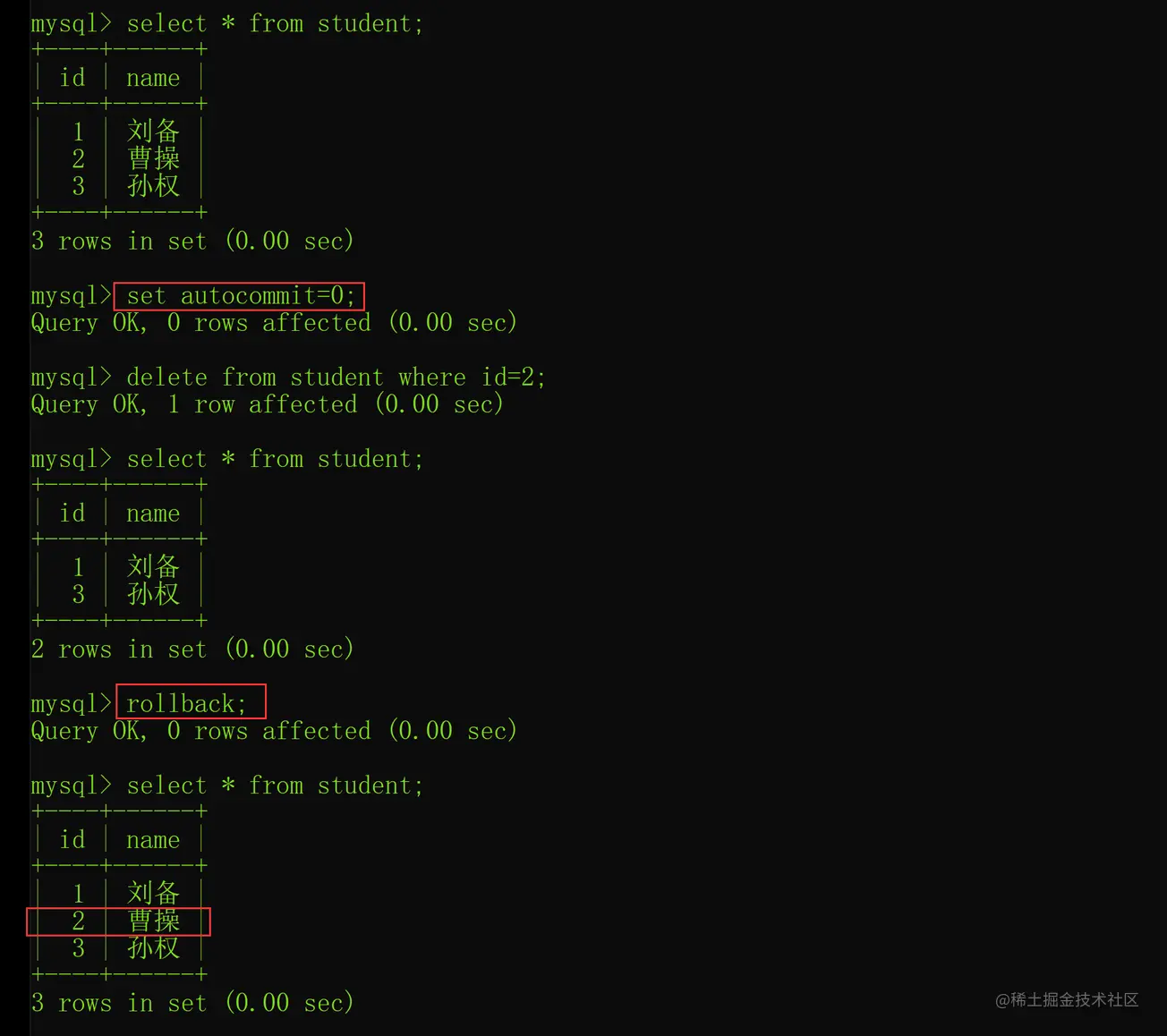 Database
Database
 Mysql Tutorial
Mysql Tutorial
 A brief analysis of MySQL deletion methods: the difference between delete, truncate, and drop
A brief analysis of MySQL deletion methods: the difference between delete, truncate, and drop
A brief analysis of MySQL deletion methods: the difference between delete, truncate, and drop

In MySQL, there are three deletion methods: delete, truncate, and drop. The usage and usage scenarios of the three are completely different. Let’s take a look at them in detail.
1.delete
detele can be used to delete some or all data in a table. Its usage syntax is as follows:
delete from table_name [where...] [order by...] [limit...]
PS: Commands in [] are optional and can be omitted.
If we want to delete the top 3 students with the highest math scores in the student table, we can use the following SQL:
delete from student order by math desc limit 3;
1.1 delete implementation principle
In the InnoDB engine, the delete operation does not actually delete the data, but marks the data for deletion and marks it as deleted. We can test this by setting MySQL to non-automatic submission mode. Verify it. The setting SQL for non-automatic commit mode is as follows:
set autocommit=0;
After that, delete a data first, then use the rollback operation, and finally verify whether the data we deleted before still exists. If the data still exists, Note that delete does not actually delete the data, it just marks the data as deleted. The verification SQL and execution results are as shown in the figure below:

1.2 About Auto-increment column
In the InnoDB engine, after using delete to delete all data, the auto-increment column will not be reset to its initial value. We can verify it with the following command:

2.truncate
The execution effect of truncate is similar to delete. It is also used to delete all rows of data in the table. Its usage syntax is as follows:
truncate [table] table_name
The biggest difference between truncate and delete in use is that delete can use conditional expressions to delete part of the data, while truncate cannot add conditional expressions, so it can only delete all row data, such as the following After adding the where command to truncate, an error will be reported:
2.1 Implementation principle of truncate
truncate seems to only delete row data. But it is a DDL statement, which is Data Definition Language. It is used to maintain the structural instructions of stored data, so this is different from the delete command. The delete statement belongs to DML, Data Manipulation Language. Used to operate on data. Why does truncate only delete row data but not column data (fields, indexes, etc.) but it is DDL language? This is because truncate essentially creates a new table structure and then deletes the original table, so it belongs to the DDL language, not the DML language.
2.2 Reset the auto-increment column
truncate will reset the auto-increment column in the InnoDB engine, as shown in the following command:

3.drop
drop is different from the first two commands that only delete the row data of the table. drop will delete the row data of the entire table and the table structure together. , its syntax is as follows:
DROP [TEMPORARY] TABLE [IF EXISTS] tbl_name [,tbl_name]
where TEMPORARY means temporary table. Under normal circumstances, this command will be ignored.
drop Usage examples are as follows:
The difference between the three
Data recovery: delete can recover deleted data, but truncate and drop cannot recover deleted data.
Execution speed: drop > truncate > delete.
In terms of deleting data: drop deletes the entire table, including row data, fields, indexes and other data, while truncate and drop only delete row data.
In terms of adding conditions: delete can use where expressions to add query conditions, while truncate and drop cannot add where query conditions.
Resetting auto-increment columns: In the InnoDB engine, truncate can reset auto-increment columns, but delete cannot reset auto-increment columns.
Summary
delete and truncate can be used to delete row data in the table, while drop deletes the entire table. The deleted data includes all Row data, fields, indexes and other data. Data deleted by delete can be recovered, while truncate and drop are irrecoverable. However, in terms of execution efficiency, the latter two deletion methods have great advantages, so they should be based on the actual scenario. To select the corresponding deletion command, of course, you should also be careful when using truncate and drop, which are unrecoverable data deletion methods.
[Related recommendations: mysql video tutorial]
The above is the detailed content of A brief analysis of MySQL deletion methods: the difference between delete, truncate, and drop. For more information, please follow other related articles on the PHP Chinese website!

Hot AI Tools

Undresser.AI Undress
AI-powered app for creating realistic nude photos

AI Clothes Remover
Online AI tool for removing clothes from photos.

Undress AI Tool
Undress images for free

Clothoff.io
AI clothes remover

Video Face Swap
Swap faces in any video effortlessly with our completely free AI face swap tool!

Hot Article

Hot Tools

Notepad++7.3.1
Easy-to-use and free code editor

SublimeText3 Chinese version
Chinese version, very easy to use

Zend Studio 13.0.1
Powerful PHP integrated development environment

Dreamweaver CS6
Visual web development tools

SublimeText3 Mac version
God-level code editing software (SublimeText3)

Hot Topics
 MySQL's Role: Databases in Web Applications
Apr 17, 2025 am 12:23 AM
MySQL's Role: Databases in Web Applications
Apr 17, 2025 am 12:23 AM
The main role of MySQL in web applications is to store and manage data. 1.MySQL efficiently processes user information, product catalogs, transaction records and other data. 2. Through SQL query, developers can extract information from the database to generate dynamic content. 3.MySQL works based on the client-server model to ensure acceptable query speed.
 How to start mysql by docker
Apr 15, 2025 pm 12:09 PM
How to start mysql by docker
Apr 15, 2025 pm 12:09 PM
The process of starting MySQL in Docker consists of the following steps: Pull the MySQL image to create and start the container, set the root user password, and map the port verification connection Create the database and the user grants all permissions to the database
 Laravel Introduction Example
Apr 18, 2025 pm 12:45 PM
Laravel Introduction Example
Apr 18, 2025 pm 12:45 PM
Laravel is a PHP framework for easy building of web applications. It provides a range of powerful features including: Installation: Install the Laravel CLI globally with Composer and create applications in the project directory. Routing: Define the relationship between the URL and the handler in routes/web.php. View: Create a view in resources/views to render the application's interface. Database Integration: Provides out-of-the-box integration with databases such as MySQL and uses migration to create and modify tables. Model and Controller: The model represents the database entity and the controller processes HTTP requests.
 Solve database connection problem: a practical case of using minii/db library
Apr 18, 2025 am 07:09 AM
Solve database connection problem: a practical case of using minii/db library
Apr 18, 2025 am 07:09 AM
I encountered a tricky problem when developing a small application: the need to quickly integrate a lightweight database operation library. After trying multiple libraries, I found that they either have too much functionality or are not very compatible. Eventually, I found minii/db, a simplified version based on Yii2 that solved my problem perfectly.
 Laravel framework installation method
Apr 18, 2025 pm 12:54 PM
Laravel framework installation method
Apr 18, 2025 pm 12:54 PM
Article summary: This article provides detailed step-by-step instructions to guide readers on how to easily install the Laravel framework. Laravel is a powerful PHP framework that speeds up the development process of web applications. This tutorial covers the installation process from system requirements to configuring databases and setting up routing. By following these steps, readers can quickly and efficiently lay a solid foundation for their Laravel project.
 How to install mysql in centos7
Apr 14, 2025 pm 08:30 PM
How to install mysql in centos7
Apr 14, 2025 pm 08:30 PM
The key to installing MySQL elegantly is to add the official MySQL repository. The specific steps are as follows: Download the MySQL official GPG key to prevent phishing attacks. Add MySQL repository file: rpm -Uvh https://dev.mysql.com/get/mysql80-community-release-el7-3.noarch.rpm Update yum repository cache: yum update installation MySQL: yum install mysql-server startup MySQL service: systemctl start mysqld set up booting
 MySQL and phpMyAdmin: Core Features and Functions
Apr 22, 2025 am 12:12 AM
MySQL and phpMyAdmin: Core Features and Functions
Apr 22, 2025 am 12:12 AM
MySQL and phpMyAdmin are powerful database management tools. 1) MySQL is used to create databases and tables, and to execute DML and SQL queries. 2) phpMyAdmin provides an intuitive interface for database management, table structure management, data operations and user permission management.
 Centos install mysql
Apr 14, 2025 pm 08:09 PM
Centos install mysql
Apr 14, 2025 pm 08:09 PM
Installing MySQL on CentOS involves the following steps: Adding the appropriate MySQL yum source. Execute the yum install mysql-server command to install the MySQL server. Use the mysql_secure_installation command to make security settings, such as setting the root user password. Customize the MySQL configuration file as needed. Tune MySQL parameters and optimize databases for performance.







